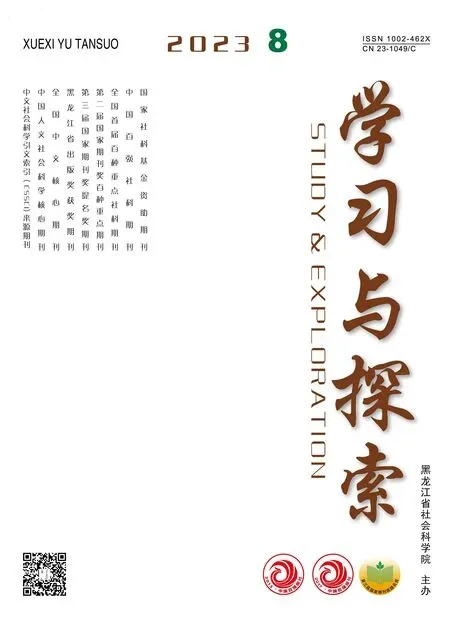ABSTRACTS
2023-02-26
Components,TypeClassificationandDifferentiationPromotionApproachesofaChinesePathtoModernization
SUN De-chao, YU Cai-ni
(SchoolofPublicAdministration,JilinUniversity,Changchun130012,China)
Abstract:A Chinese path to modernization is a socialist modernization with Chinese characteristics under the leadership of the Communist Party of China. Unlike the previous research which compares the modernization of China and the West horizontally and sorts out the experiences and interprets the values of a Chinese path to modernization vertically, this research analyzes the components of a Chinese path to modernization, that is, modernization of “things”, modernization of governance and modernization of “people”.Then, this research uses a two-dimensional quadrant analysis method, regards modernization of “things” and modernization of governance as two dimensions, and classifies and examines the basic characteristics and developmental needs of four types, namely, balanced development type, technology driven type, governance driven type and primitive spontaneity type, which is conducive to the targeted exploration of differentiation promotion approaches of a Chinese path to modernization. Based on the balanced development type, it is necessary to comprehensively plan for high-quality development of modernization; based on the technology driven type, it is necessary to focus on improving the modernization level of governance; based on the governance driven type, it is necessary to focus on improving the modernization of “things”; based on the primitive spontaneity type, it is necessary to plan for the coordinated progress of modernization of “things” and governance.
Keywords:A Chinese Path to Modernization; Modernization of Governance System and Governance Capability; Modernization of “Things”; Modernization of “People”
MemoryCommunityConstructioninAcceleratingSociety:AComprehensiveTemporalAnalysisFramework
SI Wen-jing
(DepartmentofSociology,NankaiUniversity,Tianjin300350,China)
Abstract:Time is an important dimension of memory research, and accelerating society poses new challenges to memory research. Nowadays, with scientific and technological progress, social changes and accelerating pace of life, how can individuals cope with the contradiction between “information explosion” and “short memory”, and how can they realize a meaning life by the construction of memory community? In order to answer these questions, we try to use the theory of accelerating society to reflect on how individuals can realize the memory community building through life memory and public memory construction, which may also lead to social unity and social identity in the end.
Keywords:Accelerating Society; Temporal Structure; Life Memory; Public Memory; Memory Community
ThematicUnityinMaxWeber’sWorksandtheMysteryofHisDisciplineIdentityConversion:OnWeber’sIdeologicalSystemBasedonHisMethodologicalTheories
ZHANG Yi-fei
(CollegeofHumanitiesandSocialSciences,HarbinEngineeringUniversity,Harbin150001,China)
Abstract:The traditional Weber interpretation paradigm ignores the importance of Weber’s methodological theories, which leads to an interpretation dilemma. Weber, who was originally a professor of national economics, wanted to bridge the methodological debates in national economics with the idea of “social economics”. This idea focused on the construction of ideal types in “societal domains” and aimed at the analysis of affinity and tension between the domains, and ultimately served Weber’s value relevance---Why the West had produced modern rational capitalism. Weber assigned the task of constructing ideal types to sociology, believed that it preceded historical research in methodology, and then took it as the focus in his later career. Each ideal type is essentially a subjective meaning type, which realizes the purpose of understanding. Weber’s ideological heritage provides abundant resources for today’s sociology to break the status of the remaining disciplines.
Keywords:Thematic Unity in Max Weber’s Works;Max Weber’s Methodological Theory;Max Weber’s Ideological System;Understanding Sociology; Historical School of National Economics
OntheDistinctioninEquityTransferGuarantee
HU Xiao-jing
(SchoolofLaw,JilinUniversity,Changchun130012,China)
Abstract:Equity transfer guarantee involves related debtor-creditor relationship, equity transfer and equity guarantee, including the declaration of will of equity transfer and equity guarantee. Taking the time when the creditor’s right expires and the debtor fails to perform the debt as the cut-off point, the process of equity transfer guarantee can be divided into two stages: guarantee fiducia and equity sale. In the stage of guarantee fiducia, the ownership of equity in legal sense and economic sense is separated. In the legal sense, the equity ownership is transferred, and the creditor becomes the shareholder and enjoys the shareholder’s rights. In the economic sense, the equity still belongs to the debtor/guarantor and cannot become the liability property of the creditor. The debtor/guarantor and creditor can make an agreement on the exercise of shareholders’ rights in the equity transfer guarantee contract, but the agreement is only valid between the parties and cannot be extended to the company. If the debtor fails to perform the debt within the expiration of the creditor’s right, the creditor has the right and obligation to dispose the equity in his name and return the remaining funds after priority payment of its creditor’s right to the debtor/guarantor. Only by adhering to the principle of distinction in the equity transfer guarantee, we can distinguish the legal boundaries in the application of contract law, company law and property law in order to achieve the balance of interests among the relevant subjects involved in the equity transfer guarantee.
Keywords:Equity Transfer Guarantee; Equity Transfer; Equity Guarantee; the Principle of Distinction
